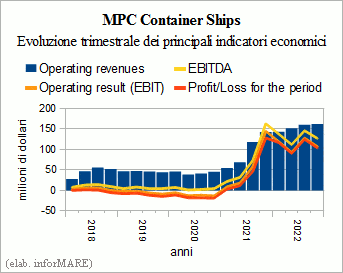
The Norwegian MPC Container Ships, a company incorporated in the 2017 with the aim of investing in the container holder sector acquiring a fleet to be leased that currently has a 61 vessels with a total hold capacity of 131 thousand teu
(
of
23 May 2017), closed 2022 with financial results record, in the wake of the very positive phase of the containerized sea transport that began to show Clear signs of weakening in the latter part of the year.
In 2022, MPC Container Ships' revenues reached historical peak of 616,8 million dollars, with a rise of +60.3% on the previous financial year. EBITDA is State of 522,2 million (+79.8%), the operating profit of 446,9 million (+93.7%) and profit clearly of 435,0 million dollars (+129.1%).
In the fourth quarter of last year alone, revenues totaled 162,1 million dollars, with an increment of +13.7% on the same period of 2021. On the other hand, both the margin is decreasing EBITDA which amounted to € 127.0 million (-22.0%) both the operating profit turned pairs to 106,9 million (- 26.1%) and The profit clearly dropped of -19.0% to 103,6 million dollars.
Illustrating the results achieved in 2022, the administrator delegate of MPC Container Ships, Constantin Baack, defined positive future prospects for MPCC and for the containerized sea transport on the basis of considerations that differ significantly from those of other market participants, Believing that the prospects for the Norwegian company are better than other shipping players in consideration also the type of its fleet which is formed by ships of limited capacity, between 1.223 teu and 4.256 teu, for an average of 2,156 teu, therefore more suitable for intra-regional traffic. 'The availability of vessels on the market - he explained - is significantly reduced compared to to historical averages. In addition, the general improvement of World economy outlook in recent months - he said Baack - bodes well for the medium-term prospects of container markets, in particular for traffic intra-regional, for which the balance between supply and demand appears decidedly more favourable than for the transport on long routes'.
